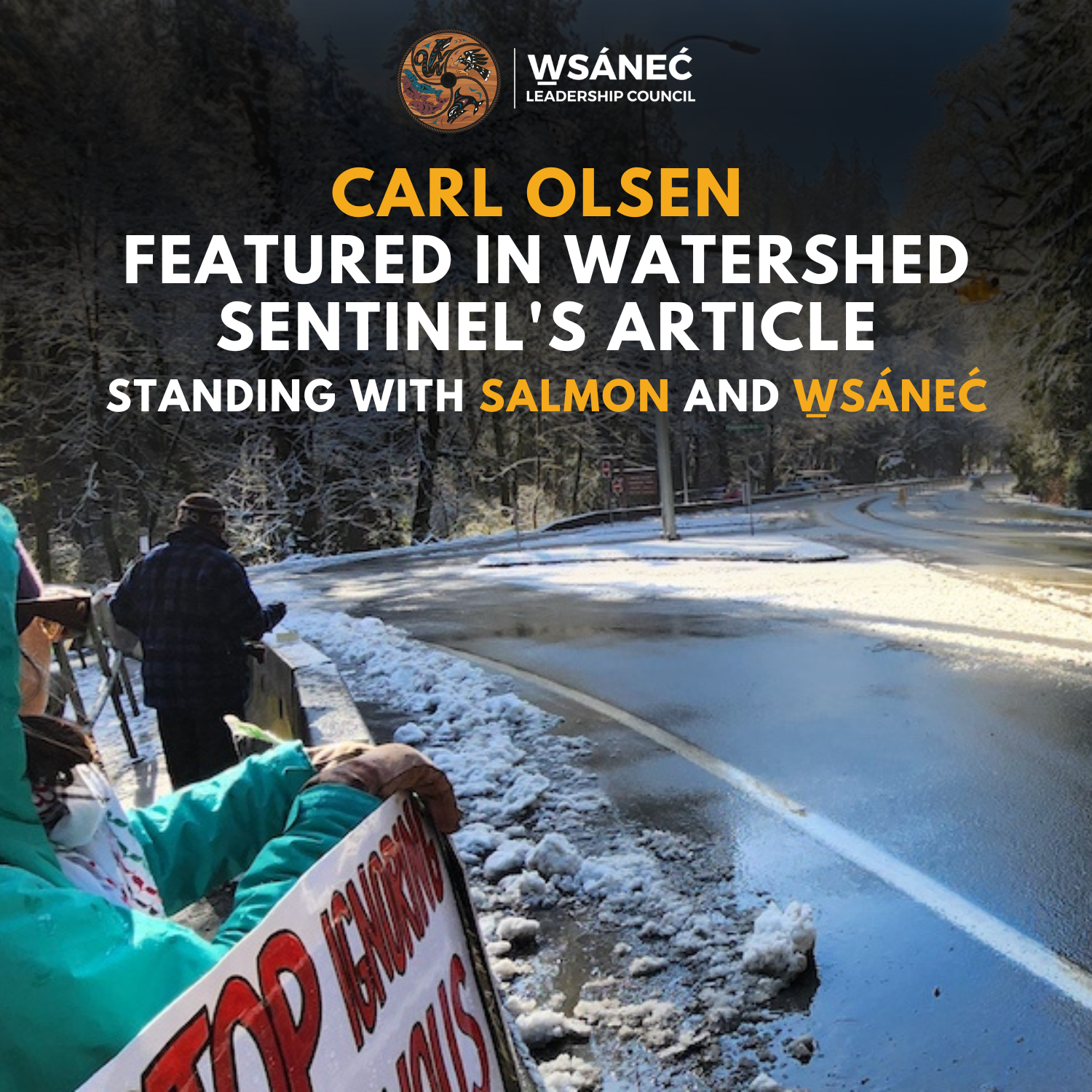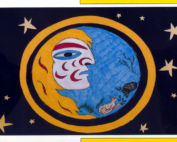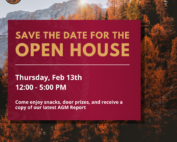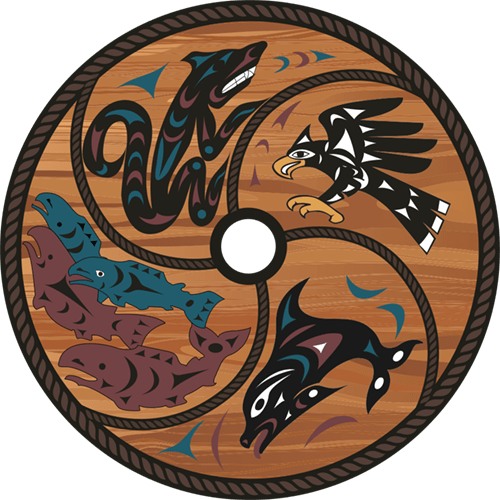Carl Olsen featured in Watershed Sentinel’s Article: Standing With Salmon and WSÁNEĆ
“If you take a look at the treaty, the treaty says that we have a right to look after what feeds us and what looks after us.” — W̱SÁNEĆ Elder Carl Olsen

It’s a cold morning and I shiver as I walk over to the line of people holding placards by the concrete barrier at the side of the road. It snowed on the Malahat last night but now the sun has come out and large drops are falling from the high snow-covered branches.
I go through the remaining signs leaning against the barrier and pick two: “Save the Salmon” and “Stop Ignoring Indigenous Concerns.” A box of Tim Hortons tea and a box of Timbits sit in front of the signs. I grab a tea and join the line; only five of us today. We stand behind the barrier on the northbound side of the Malahat highway. At the end of the line is 76-year-old W̱SÁNEĆ Elder ZȺWIZUT Carl Olsen from Tsartlip, wearing his Goldstream Hatchery ball cap and a Cowichan sweater.
Every Tuesday since February 2023, from 10 am until noon, Carl stands at this site. His mission is clear: to stop the Ministry of Transportation and Infrastructure’s (MOTI) plan to widen the highway inside the boundaries of Goldstream Provincial Park. The plan includes installing a median barrier, blasting some rock, cutting down 700-plus trees that shade SELEK-TEL- (Goldstream River), as well as building a retaining wall that will intrude into the river’s bank and eliminate a trail beside the river, replacing it with a cantilevered metal walkway over the river.
Carl is a W̱SÁNEĆ knowledge-holder and a community resource on salmon conservation and clam beds for Coast Salish Nations. He knows what this plan will do to the salmon and all the more-than-human beings who live here. He is willing to go to court using the Douglas Treaty’s promise to protect the rights of the W̱SÁNEĆ to hunt and fish as formerly. Carl is a seasoned veteran of the Canadian legal system, having won a 2006 Supreme Court Case with Ivan Morris, another Tsartlip member, that concluded their right to hunt deer at night using lights was protected by the Douglas Treaty.
“If you take a look at the treaty, the treaty says that we have a right to look after what feeds us and what looks after us.” — W̱SÁNEĆ Elder Carl Olsen
I ask Carl why SELEK-TEL- is so important. “The reason I have been here for more than a year,” he says, “is that we have a responsibility to look after this place that has provided for us for thousands of years, both in the way of salmon and the environment itself with foods and plants and medicines. It is really important that we start looking after the environment in a good way, in a way that that is meaningful and protects those who can’t protect themselves – the fish, the salmon, the birds. If you take a look at the treaty, the treaty says that we have a right to look after what feeds us and what looks after us.”
The W̱SÁNEĆ have used this argument before, in the Saanichton Bay Marina case in 1987. In that decision the court acknowledged that the W̱SÁNEĆ people have the right under the Douglas Treaty to hunt and fish as formerly and to protect the area where they harvest shellfish. Olsen says, “By widening the highway, it puts the species of salmon in danger. I believe we already had the rights before, but the Douglas Treaty confirms our right.”
Every Tuesday, all kinds of people – young and old, Indigenous and non-Indigenous – show up to join Carl. One day, I talked to Tracy Underwood from Tsawout. She has been coming out here regularly, responding to her uncle Carl’s call for support on Facebook. She stressed how important SELEK-TEL- is for her family. “My whole life, my brothers, my sons, my elders, and younger sons all fish here. They’ve filleted and smoked the fish here.” She showed me a video of her sons fishing with long gaffed poles. She noted there are many W̱SÁNEĆ stories connected to the Goldstream River.
I am interested in why so many non-Indigenous folks are showing up to support Carl and to protect the Goldstream River. Justin Schaible, marine biologist and law student, tells me he has been out here every Tuesday since October. “I did a field course on Resurgence of Indigenous Law with Dr. Rob Clifford, W̱SÁNEĆ legal scholar. I learned how important the Goldstream area is for the W̱SÁNEĆ spiritually, and a place where the salmon can be harvested and dried. And if you look around you see how beautiful it is and how well the W̱SÁNEĆ have taken care of this place. It is time to stand up and say enough is enough.”
Schaible adds, “The Douglas Treaty was not a treaty to cede land but to share the land, and part of that is the responsibility of everyone here now to take care of this place in the same way as the W̱SÁNEĆ would, as part of our responsibility for being here. The WSANEC have the right to fish as formerly and to have access and management of this fishery as well.”
The Indigenous signatories all understood the oral agreements they made with Douglas as Peace and Friendship treaties. Douglas later affixed to the blank page on which they had signed their names a short statement, copied from a previous British treaty with the Maori, that stated that these groups had surrendered their land to the white man.
Gabrielle Lucier, who has been coming out weekly since before Christmas, shares, “At first, I kind of knew the ecological side of it and was concerned about the well-being of the salmon as a really important species ecologically and culturally. After talking with others and Carl, I learned about the political side of this, and I learned more about the local treaties and our responsibilities as settlers to uphold our side of the treaties. It is important to ensure our government is being held responsible for their treaty responsibilities.”
Evelyn Peters, a Unitarian who has started to come out regularly, adds, “It is one of the few thing I can actually do in the context of reconciliation. So many things have happened over the years that are really hard to roll back or change or undo but this at least I can do.”
What is new is that more and more non-Indigenous people are becoming aware of the Douglas Treaties. Between 1850 and 1854, Vancouver Island governor James Douglas met with 14 Vancouver Island family and community groupings – 11 in the Victoria and Saanich Peninsula area, one at Fort Nanaimo, and two at Fort Rupert. The Indigenous signatories all understood the oral agreements they made with Douglas as Peace and Friendship treaties. Douglas later affixed to the blank page on which they had signed their names a short statement, copied from a previous British treaty with the Maori, that stated that these groups had surrendered their land to the white man. This trickery was publicly exposed in 2017 at the Songhees Conference on the Douglas Treaties, which resulted in the book To Share, Not Surrender.
Despite the growing opposition, the BC government included a $162 million plan to “improve” the Malahat corridor at Goldstream Park in their February 2024 budget. This has not fazed the W̱SÁNEĆ. The W̱SÁNEĆ Leadership Council (WLC) has managed to get the government to pause while they do their own engineering study of road safety and the climate challenges to the river. Robert Clifford, in his study of W̱SÁNEĆ legal theory and the 2011 fuel spill at SELEK-TEL-, describes how “the W̱SÁNEĆ tradition is decentralized and its driving impetus is to repair and maintain relationships in an encompassing way…. To repair relationships in W̱SÁNEĆ law, both between humans and with the land and animals, many people (including Elders, knowledge holders, chiefs and community members) have a say.” The WLC has had several community engagement sessions and done a community survey of members.
The group I am part of, Reconciling with Indigenous Peoples and The Land (RIPL) out of James Bay United Church, has learned to let go of our agenda and to prioritize support of the W̱SÁNEĆ process, rather than propose our solutions.
When I went out to Goldstream last Tuesday, one of the regulars announced she was moving to the Interior, but she promised she would be back if needed. This is a determined group holding the line, or, for now, the signs. At noon we bring the signs back to Carl’s truck and have a goodbye tea with Timbits and coffee on the tailgate of Carl’s truck. Carl, as always, offers the remaining Timbits and coffee to someone at the park, today a group of disabled folks picnicking by the river. Reciprocity is alive and well at SELEK-TEL-.






